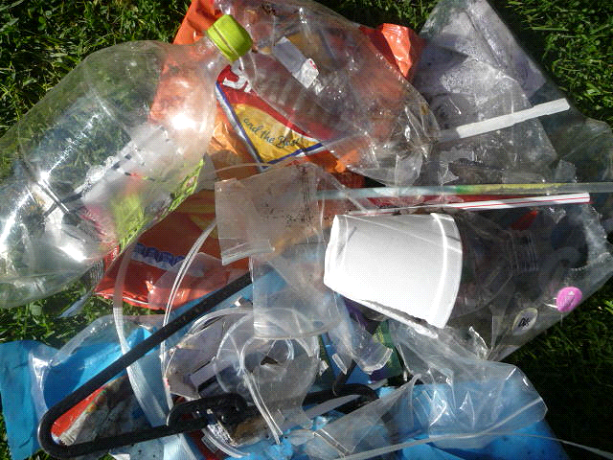In One’s Cups – Going Green
Posted on April 14, 2012 by DrRossH in BioPlastics, Landfills and Disposal, Plastic Waste NewsThere are many inaccuracies in this article that if not bought out can misinform a reader of the actual process.
1) The word Biodegradable at the consumer level is horribly misused. it comes down to where the biodegradation process is engineered to happen by the manufacturer. There is;
a) compost biodegradable where a product will only biodegrade in commercial composting conditions. Plenty of oxygen, temps above 60 deg C and moisture. Not home compost piles. Even then many composters will not take compostable plastic as they clog up their processes. Commercial compost facilities are few and far between and there is no special collection of compostable plastics, so this renders the concept of compostable plastics not a user friendly option.
b) There are landfill biodegradable additives that when added to plastics they will biodegrade in a landfill with moisture. This can be with or with or without oxygen present. (See www.goecopure.com for an example).
c) There is oxodegradable additives which is not biological but a chemical reaction that causes the plastic in the presence of oxygen to fragment into little pieces. This is actually worse for the environment. This is what the author is confused about, but is correct they will not break down in a landfill due to lack of oxygen.
2) Compostable plastics biodegrade to CO2 and any energy that was stored in the plastic is lost in the biodegradation process.
3) Landfill biodegradable plastics when biodegrading in a landfill without oxygen present produce methane, CH4. This gas can be captured to combusted to produce energy or Electricity. i.e. the energy in the plastic is recovered.
4) Oxodegradable plastics do nothing but make lots of little plastic bits that get into the water ways and our environment. That is not what we want.
Recycling is what we should do first. But if every piece of disposable plastic was made with a landfill biodegradable additive in it, then if the item was recycled 10 times before it became unusable for some reason and it was sent to a landfill, then it would break down. For those modern landfills that capture the methane, we would get its energy back. We call this the BACKSTOP method for plastics as no matter if the item is recycled or landfilled, either way the plastic item is gone and not sitting as plastic waste for the next 300 years. Why should our future generations deal with our plastic waste that we used just because it provided us a few minutes of convenience for us to use?

 How many people today grab a takeaway coffee cup from the local cafe to drink on the go? We don’t know, but the number must be enormous.. Most every one of the above have a plastic top that will last 100s of years. Some cafes still use plastic cups that last a similar time. Is 10 minutes of coffee worth 100s of years of trash?
These items can be seen littering our gutters and on our streets all over the place. If they were all cardboard, they would still be littered, but they would, at least, be gone in a short time.
They do not need to be made of plastic.
How many people today grab a takeaway coffee cup from the local cafe to drink on the go? We don’t know, but the number must be enormous.. Most every one of the above have a plastic top that will last 100s of years. Some cafes still use plastic cups that last a similar time. Is 10 minutes of coffee worth 100s of years of trash?
These items can be seen littering our gutters and on our streets all over the place. If they were all cardboard, they would still be littered, but they would, at least, be gone in a short time.
They do not need to be made of plastic.
 On the way home from the gym last week, a distance of about 1 km (1/2 mile), I counted the items of plastic litter on the curb as I walked. In that short distance I counted 63 pieces of plastic litter. Plastic drink bottles, bottle tops, candy wrappers, plastic film, polystyrene fragments etc. That seemed to be a lot to me. I guess it is a generational thing. Our parents would have been horrified to see that amount, whereas it seems to go unnoticed by our youth of today. In another 20 years how many pieces will there be on this stretch, -- 200? What will today’s youth think of that new amount then when they are older? Will their children be so readily accepting of a higher amount of litter?
On the way home from the gym last week, a distance of about 1 km (1/2 mile), I counted the items of plastic litter on the curb as I walked. In that short distance I counted 63 pieces of plastic litter. Plastic drink bottles, bottle tops, candy wrappers, plastic film, polystyrene fragments etc. That seemed to be a lot to me. I guess it is a generational thing. Our parents would have been horrified to see that amount, whereas it seems to go unnoticed by our youth of today. In another 20 years how many pieces will there be on this stretch, -- 200? What will today’s youth think of that new amount then when they are older? Will their children be so readily accepting of a higher amount of litter?
Discussion · No Comments
There are no responses to "In One’s Cups – Going Green". Comments are closed for this post.Oops! Sorry, comments are closed at this time. Please try again later.